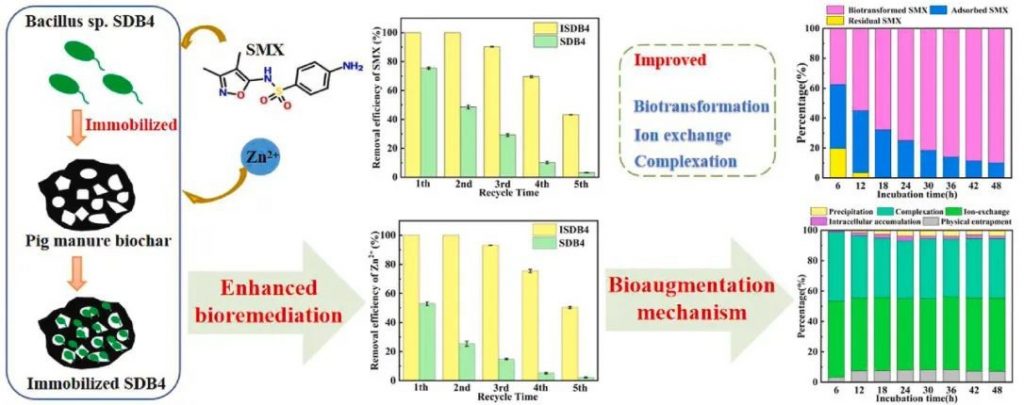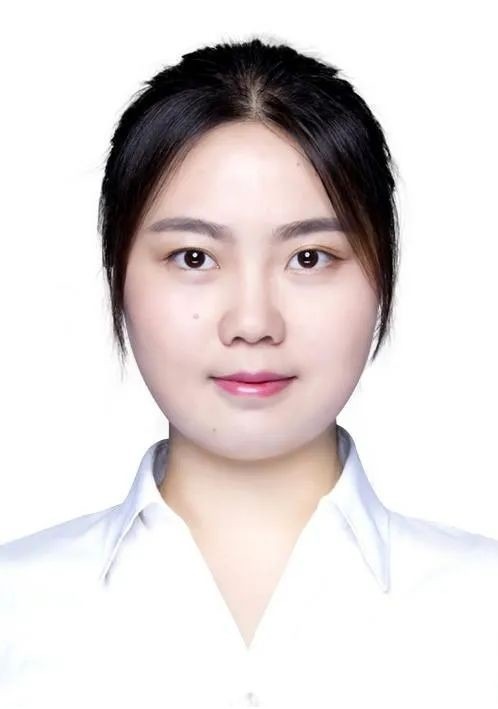First author: Chen Xi
Corresponding authorProf. Lin Hai, Prof. Yingbo Dong
Communication UnitSchool of Energy and Environmental Engineering, University of Science and Technology Beijing
DOI: 10.1016/j.jclepro.2022.133483
✦Image Summary✦

✦Results Profile✦
Recently, Chen Xi, a PhD student in the group, published an article entitled "Mechanisms underlying enhanced bioremediation of sulfamethoxazole and zinc(II) by Bacillus sp. SDB4 immobilized on biochar". In this study, biochar-immobilized Bacillus sp. SDB4 was prepared to overcome the drawbacks of slow growth of free bacteria and sensitivity to environmental changes.The effects of free bacteria SDB4 and immobilized bacteria ISDB4 on sulfamethoxazole (SMX) and Zn(II) were investigated under different initial pH and concentration of the complex pollutants.2+of simultaneous removal. In addition, the reusability of SDB4 and ISDB4 was investigated. The results were analyzed by scanning electron microscopy energy spectroscopy (SEM-EDS) analysis, infrared spectroscopy (FTIR) analysis, SMX adsorption and conversion experiments, and Zn2+Desorption experiments were conducted to clarify the qualitative and quantitative contributions of chemisorption, biotransformation, ion exchange, and complexation mechanisms to the removal of complex pollutants by SDB4 and ISDB4, revealing that biochar can contribute to the simultaneous removal of SMX and Zn by ISDB42+The biofortification mechanism of the
✦Abstract✦
Microbial remediation is a method of removing both SMX and Zn2+environmentally friendly method for complex contaminants. However, the sensitivity of free-living bacteria to environmental changes limits its application. In this study, biochar-immobilized Bacillus sp. SDB4 was used to overcome this drawback. The results showed that under different initial pH and composite pollutant concentration conditions, the sensitivity of ISDB4 to SMX and Zn2+The removal efficiency was significantly higher than that of SDB4. It is noteworthy that at pH=7, 20 mg-L-1of SMX and 100 mg-L-1of Zn2+could be completely removed by ISDB4, with removal rates higher than SDB4 by 29.28% and 92.34%, respectively. in addition, ISDB4 showed good reusability in 5 consecutive cycles, with the 5th cycle use for SMX and Zn2+The removal rates were 43.24% and 50.34%, respectively. compared to SDB4, the biotransformation of SMX by ISDB4 increased from 45.81% to 89.98% and Zn2+The ion exchange and complexation contributions of ISDB4 were increased by 9.53% and 6.72%, respectively.SEM-EDS and FTIR analyses showed that in the ISDB4 system, biochar provided enough space for the attachment and proliferation of SDB4, and the presence of functional groups and light metals on biochar enhanced the removal of complex pollutants by SDB4. This study provides a green and effective strategy for the bioremediation of farm wastewater polluted by a combination of antibiotics and heavy metals.
✦Author✦

Chen Xi, a PhD student of Environmental Science and Engineering, University of Science and Technology Beijing, Class of 2018, is engaged in the research of water pollution control, biotechnology research and development, and environmental microecological characteristics. He has participated in "Research, Development and Demonstration of Key Technology for Green Mining of Deep Metal Ore" (13th Five-Year Plan Key Research and Development Project), "Research and Demonstration of Key Technology for the Whole Process Control of Heavy Metal Pollution of Special Minerals in Danjiangkou Reservoir Basin" (12th Five-Year Plan Water Project), and "Research and Demonstration of Multi-water Source Allocation and Scheduling Technology for Ecological Baseflow Guarantee of the Guishui River" (13th Five-Year Water Special Project), Research on COD Source Analysis and Treatment Technology of Acidic Water in Yinshan Copper Mine, and Monitoring and Evaluation of Rural Drinking Water Sources in Tongzhou District, and many other projects. Finally, I would like to congratulate Dr. Chen Xi once again and wish the graduate students of the subject group to keep innovating, make further efforts and achieve fruitful results.
Source: Environmental Biotechnology and Environmental Materials Development Team Public

